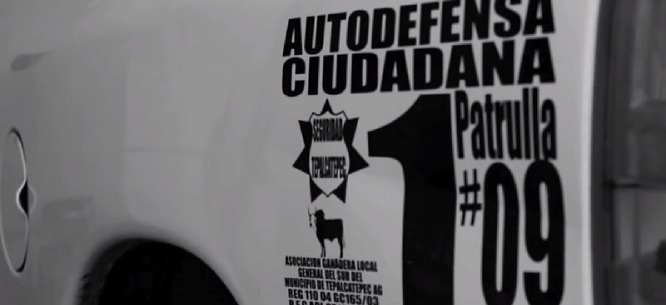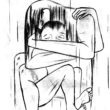Self-defense groups have emerged throughout Mexico in recent years. In the last week, they acquired a prominent role in the south of the state of Michoacán, where they have fought drug-trafficking gunmen out of towns in which they used to rule unobstructed by the police, extracting a heavy toll from local populations. The image of Mexican civilians holding weapons, some old single-shot hunting rifles, some AK-47s, is disturbing even for those who can see it from a safe distance.
| Most likely, the autodefensas are now pretending to disarm and the army is pretending to make sure that happens, while both maintain some form of negotiated collaboration. |
Yet through the internet, representatives of these autodefensa groups tell a compelling story: The Caballeros Templarios organization, which used to run its productive drug-trafficking business without major disruptions to the rest of the population, began at some point (the exact moment varies according to different accounts) to extract “taxes” out of almost all economic activity, from cattle trading to selling tortillas. More recently, the Caballeros took to raping women and kidnapping minors. This, the autodefensas claim, was the tipping point. Since the government provided no protection for them, they organized secretly and one day came out and took back their towns. This meant chasing away gunmen and setting up roadblocks to prevent them from coming back. In some instances, the groups disarmed and arrested the local police before acting against the criminals. They captured some of them and delivered them to the authorities, but seeing that the criminals would be released even if they had committed serious crimes, they began to keep their own prisons. Yet, they emphasize, their goal is not to replace the government, and they only reluctantly took up arms.
It is difficult to corroborate or contradict this narrative. Journalists have a hard time getting the facts out, because they face serious risks in their daily work. Mexico continues to be one of the most dangerous places for the profession in the world, as violence against journalists by criminal organizations and corrupt officials is unlikely to ever lead to prosecutions. Most important, perhaps, the national media, based in Mexico City, have been reluctant to cover the story, seeing the autodefensas as an ugly new facet of an already ugly situation.
In the liberal and progressive outlets, autodefensas smell too much like the mobs of Catholic peasants that rebelled against the government in the late 1920s in Michoacán and other states in the Cristero war, or like the dangerous lynch mobs that, in urban myth, threatened any driver who killed a donkey on the highway. There were rumors on the Internet that other drug organizations paid for the autodefensas, or that wealthy businessmen used them for security. In the state of Guerrero, even guerrillas condemned the autodefensas—perhaps out of envy for their success in arming and encouraging people to take a stance of open defiance against the government, when the guerrillas have failed to recruit a significant number of fighters since the 1960s. In the television and large newspapers that are closer to the government, the autodefensas appeared as an unacceptable challenge to the rule of law, an atavistic presence in a modern nation. All of this made good reporting scarce and stuffy opinion pieces abundant—already a tendency in much of Mexican journalism. Moreover, the nature of these autodefensa groups varies greatly from region to region, yet they are seldom examined separately and in their local context.
The lack of good information is beginning to give way, thanks to the urgency of events. When autodefensa groups moved outside their own towns to “liberate” others, including some that are central to the power of the Caballeros Templarios, like Apatzingán, things began to look too much like a civil war. The federal government was forced to act and President Enrique Peña Nieto appointed a special envoy to deal with all things related to Michoacán, from security to social development, effectively undermining the already weak authority of Governor Fausto Vallejo, a member of Peña Nieto’s party (the PRI) who just returned from a long health-related leave taken shortly after his inauguration. Federal troops poured into the region and began to enforce the government’s order to disarm. But the autodefensas resisted, arguing that if they give up their weapons the Caballeros Templarios will come back and kill them. Two sympathizers with the autodefensas died in a standoff with soldiers. Most likely, the autodefensas are now pretending to disarm and the army is pretending to make sure that happens, while both maintain some form of negotiated collaboration. Such simulation on the government’s behalf is not so difficult to imagine when one considers the cozy relations that have often developed between drug traffickers and the soldiers or police officers ordered to fight them.
It is difficult to go beyond hypotheses for the immediate future (and this probably unnerves the experts, opinion writers, and media outlets). If the army takes disarmament seriously, there could be a bloodbath. If things return to the status quo of the last few years, the criminal organizations will return with a vengeance. If the army, instead, begins collaborating with the autodefensas, vigilantism could take its own course, also with possibly bad consequences.
One thing is certain, based on historical experience: the new government intervention will come up short of its goals of peace and development. Dozens of federal interventions in Michoacán have accomplished little since former president Felipe Calderón launched his own failed (and later disavowed) “war” on drugs in 2006. This story can be generalized, with some nuances, to describe Mexico’s overall drug enforcement strategies since the 1970s.
Thus, the original source of the autodefensas‘ claim to legitimacy will remain intact: justice does not exist for the population of Michoacán, as well as for those of many other regions of Mexico. The visible leaders of criminal organizations, and most often their operatives, seldom worry about serious investigations, trials or prison. Courts and prisons are just not the way things are dealt with, except to punish minor operatives of criminal organizations; even the federal government carefully avoids talking about justice when describing its intervention. Yet, as obvious as this might sound, justice is the key to the relationship between people and the government when it comes to crime. Although commentators, advisers, and planners tend to put little emphasis on it, probably because of their focus on measurable results, autodefensas and other organizations of victims invoke justice as a right that the Constitution affords every Mexican. Yet justice for them is still elusive, except through an aggressive, illegal, and unsettling mobilization of civil society.
Pablo Piccato is professor of history at Columbia University. He writes about the history of crime and the public sphere in Mexico and Latin America. He wrote this for Dissent.







0 Comments